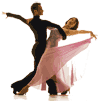 |
ROUND DANCING — CHOREOGRAPHED BALLROOMEDUCATIONAL ARTICLESMAJOR SECTIONS: Figures | Articles | Links | Alph. Index | Search | Home |
|
|
Cast Your Eyes Upwardby Harold & Meredith Sears Round dancing can be an intense activity, particularly when we are dancing a new routine, one we have only just learned or are still learning. Round dancers can develop facial expressions of intense concentration—the furrowed brow, pursed lips, little grimaces of annoyance when things don't quite work. Sometimes it seems that you just can't get that figure to work unless you hold your tongue in just the right place, poked firmly into your left cheek. Sometimes guests will watch a roomful of round dancers and ask, "Aren't they having fun? No one is smiling." Well, yes, we're having fun, but sometimes it's not the loose and jolly kind. It's more the intent and focused kind of fun. It's fun to hit a fastball out of the park, to make a hole-in-one, maybe to execute a perfect jackknife dive, but you probably won't be sporting an easy grin while you're doing it. Afterward, maybe. Our story got a little sidetracked there. We don't really want to think about the smiling but about the intensity. You might think that intensity and focus would help your dancing, but intense concentration can lead to some uncomfortable habits, too.For instance, some dancers listen hard to the cues and focus inwardly, intently searching their brains for what those cues mean, and they dance with their eyes cast down in concentration—staring blindly at the floor. Other dancers don't stare blindly, but they too look down, watching their feet, to make sure they put them where they should go. Don't do it. Don't look down. Over here is a couple who know not to watch their feet, but they too are intently focused on the cueing and the music, and they are turned inward in their attention. They have settled on their partner's right shoulder as a conveniently nearby focal point, and they are stiffly staring there. Not only are their heads down a little, but their shoulders are tensely forward. All this arises from our intense concentration on what we're doing. We have allowed our whole upper body to curve in and down, like a rush-hour driver hunched over the steering wheel. The effect of this downward and forward concentration is to push into your partner, maybe come over on top of her or him, like a vulture over a piece of road kill. You push on each other and become off-balance and jerky. So, get your eyes up, your head back and to the left, your shoulders back. Let your toplines "grow" and blossom in a spreading, vase-shape kind of way. Try to look at a point high on whatever wall you happen to be facing. Depending on the size of the ballroom, you might focus on the juncture between the wall and ceiling. By getting your eyes off the floor, off your feet, and off your partner, you get your whole upper body off and away, and both of you will feel much less oppressed. There will be less pushing and more freedom of smooth movement. Let's note that you do still have contact at the hips and lower rib cage. Helpful lead and follow occurs here, close to our centers of gravity. But any contact or pressure higher up is not lead and follow; it's just shoving. It pushes us off balance. So, expand your view as you dance, take in the wider world—get your eyes up.
This article
was published in the Washington Area Square Dancers Cooperative
Association (WASCA) Calls 'n' Cues, 49-2:9, 10/2008;
reprinted North Carolina Round Dance
Association Quarterly Newsletter, July 2012.
If you would like to read other articles on dance position, technique, styling, and specific dance rhythms, you may visit the article TOC. Past DRDC Educational Articles archived here. Go beyond this site. Find other references on our Sources and Links pages.
|
 |
|
|